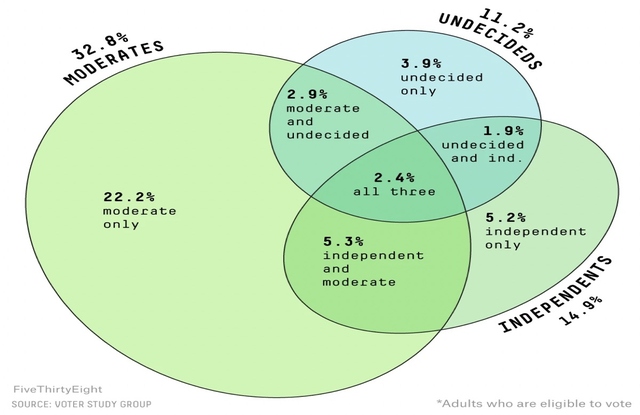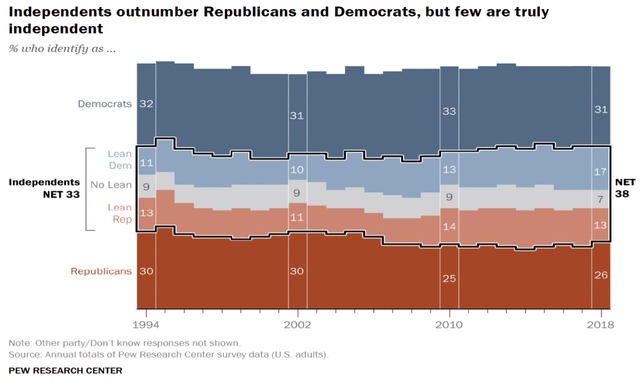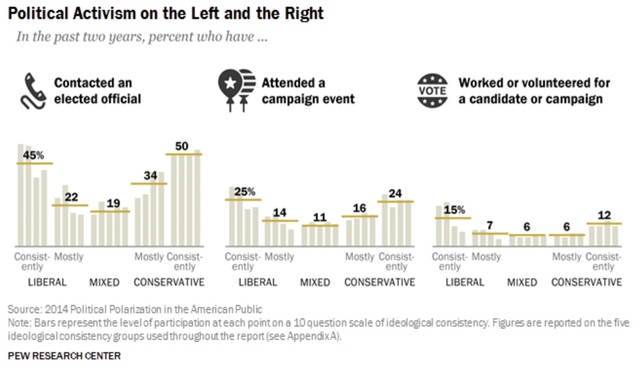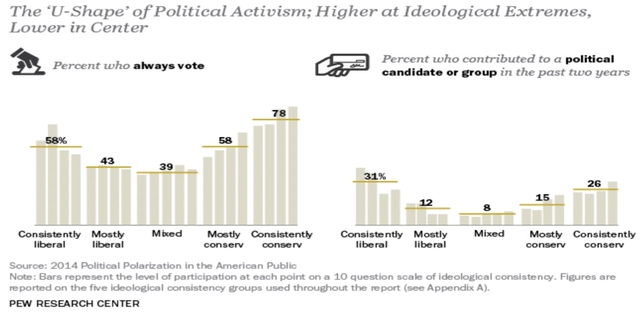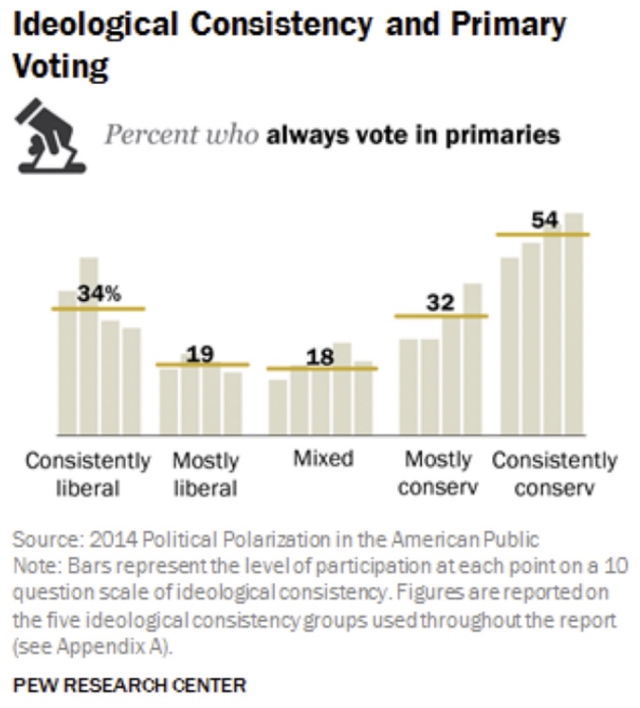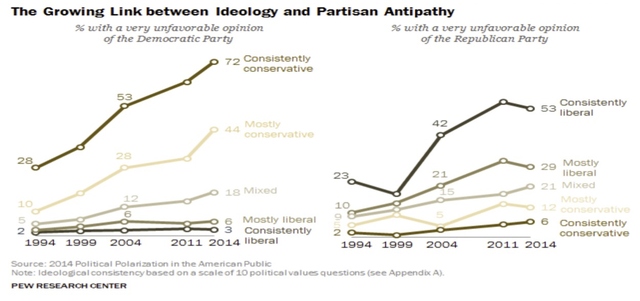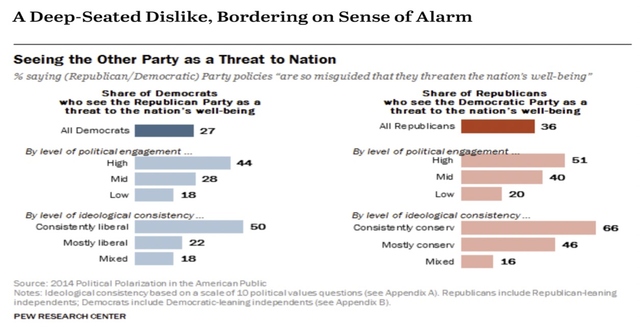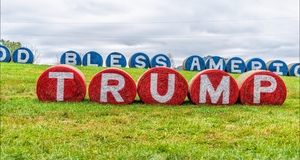The Forgotten Center: An Analysis into the Disappearing Moderate in a Climate of Increasing Political Polarization
By
2020, Vol. 12 No. 09 | pg. 1/1 AbstractPolitical polarization in the United States has been one of the main issues at the forefront of American politics. Studies show that political parties have in fact become more divided ideologically than ever, and more Americans that belong to one political party view the opposing party with disdain1. Yet as public attention remains on the two major parties moving farther away from the center, focus on the shrinking number of moderate Americans has been neglected to the point where they have been referred to as “politically homeless,” as they increasingly don’t seem to fit in with the growing extremes in both major parties2. Much of the polarization discussion is painted as a strictly ideological issue, leaving the root of the problem ignored. The systematic changes in American politics over the last few decades have allowed moderates to go ignored and ultimately our democracy threatened. Ask anyone about polarization in American politics and they will probably all agree that the United States is more divided politically than ever before. Polarization in this country and the gridlock it has caused has been a hotly discussed topic in every election in recent memory. It is Democrats vs. Republicans, that’s it. Or so it seems. A large portion of the American population describes themselves as politically independent. Political independents are 38% of the voting electorate, a larger percentage than either Democrats or Republicans3. We hear a lot about this group in the media when election season rolls around, and it’s easy to see why. They are a crucial political prize to be won over by either party in any election. And yet, outside of election season, we don’t hear too much about independent voters or more moderate ideological voters. In government, it has become rare to see an independent elected to office. For example, the last time a third-party candidate carried a state in a presidential election was over 50 years ago4. More and more these days, extreme ideologies have taken center stage. Polarization has become the new normal, or so it seems. Studies show that political independents and moderates have not just up and disappeared. Their numbers have actually stayed quite consistent over the last few decades5. Political scholars have begun to conclude more and more that the political center may not be disappearing as commonly believed6. So why does it seem as though we rarely hear from the political center anymore? The number of Americans who are ideologically consistent, or those that hold straight-line liberal or conservative attitudes across a range of issues, has doubled over the past two decades7. As more and more Americans are consistent ideologically with one end of the political spectrum, there leaves little room for moderate independents, or moderates who lean slightly towards one political ideology to have their beliefs and concerns heard. When looking at recent history, we can see how ideologies have become more hard-lined. Pew Research has found that the average, median Republican is now more conservative than nearly 94% of Democrats. The average, median Democrat is now more liberal than 92% of Republicans. When we compare these numbers to those gathered in 1994, we can see how small the ideological overlap has become. In 1994, the average, median Democrat was to the left of only 64% of Republicans, and the average, median Republican was more conservative than 70% of Democrats. In the same year, 23% of Republicans were more liberal than the average, median Democrat and 17% of Democrats were more conservative than the median Republican. In 2014, only two decades later, those numbers have shrunk to just 4% and 5% respectively. The gap in these opinions has also doubled over the last 25 years8. Keep in mind, these studies were about average Democrats and Republicans, not those at the most extreme ends of the party. Clearly what is considered “average” ideologically for both parties has drastically shifted over the last few decades.Ideological overlap between the two parties has become a thing of the past. Polarization and extremism of the two major political parties have taken the forefront, while moderates have faded back into the shadows. But how did this happen? Many want to point the finger at simply the shifting of ideologies in the political parties and growing resentment of what’s seen as the “other side.” This is too simplistic of an answer. The answer lies more in the systematic changes in American politics that we have seen over the last few decades. Political parties have lost their power and ability to control their candidates, moderates are not getting involved in politics from the very beginning of the political process, and social media has drastically changed the way we conduct politics. Fundamentally, our political process and atmosphere is not what it was decades ago. It has shifted into a ideological battlefield where only extreme partisans can thrive, and has left moderates, and the very state of our democracy in its wake. Who Exactly Are Political Moderates?It is widely believed that political moderates are individuals who do not lean towards either major political party and can be equally swayed to support and vote for candidates on both sides. Parties can count on loyal partisans to show up and support them, but with 38% of the American population labeling themselves as politically “independent”, it’s easy to see why they are considered such an important group to capture in any election9. In media and academia, political moderates have been called a variety of names. “Moderates”, “independents”, and “undecideds” are common labels for the swath of voters who do not see themselves as fully identifying with either the Republican or Democratic party. Yet using these labels interchangeably to describe the same group of people is incorrect and misleading. In fact, political “independents” and “moderates” are not nearly the same thing, and should not be treated as such. As Table 1 shows, these labels interact and overlap quite often when voters are asked to describe themselves in regards to the upcoming 2020 election. In reality, although this group of voters all have one thing in common: they do not wish to identify with one political party or the other, this group is greatly oversimplified and much more ideologically diverse than they are typically given credit for. They are all over the ideological map when it comes to their opinions on hot topics like gun control, immigration, and economic issues. Most importantly, this group of “independent” voters is not reliably centrist10. The true, independent, political moderate that is so widely discussed in popular media is actually a tiny portion of the overall electorate. Table 2 shows the results from a study conducted by Pew Research Center on American independent voters, or those that do not wish to identify with either the Democratic Party, Republican Party, or a third party. As this study shows, a majority of the American electorate describe themselves as “independent”. However, only 7% of the population is both independent and has no clear political leanings toward either party. A majority of independent voters do hold political leanings towards one of the two major parties. Now this doesn’t necessarily mean that these independent but leaning voters are secretly partisans in disguise, or that they are not moderate. They could very well be moderates who just have slight leanings that favor one party’s policy platforms over the other. Therefore, whenever there is speculation or discussion about political “independents,” it begs the question: which ones exactly are being referred to? Because the common ideal that independents are voters who hold no ideological leanings either way and can be equally swayed to vote for both political parties is flat out wrong. Lee Drutman, an author and senior fellow in the Political Reform program at New America, conducted analysis into the political moderate. His analysis found that those who identify themselves as moderate are more likely to be registered Democrats and hold center-left views on two top issues: economics and immigration. Looking at Table 2, self-described Independents also tend to lean more Democratic than Republican, 17% to 13% respectively11. Drutman theorizes that this may be due to linguistic history. He argues that Republicans have a long history of proudly embracing the “conservative” label, but Democrats have traditionally shied away from labeling themselves as “liberals,” as this word has held negative connotations. This leaves only “moderate” as an acceptable self-identification for many Democrats. Additionally, he argues, typical survey questions do not do a good enough job diversifying the ideological field. When asking the general public how they would describe themselves, surveyors often only give three options: “liberal”, “moderate”, or “conservative.” Many voters oftentimes do not see themselves as identifying fully with “liberal” or “conservative” so they will describe themselves as “moderate” since it’s the only other option they are given. Because of this, many political scientists have deemed the term “moderate” as meaningless, since it is inaccurate to expect people to fully commit themselves to a political label when so many Americans hold varying beliefs all over the ideological spectrum12. In terms of this analysis, “moderate” will refer to Americans who have political beliefs that fall between the two political extremes of liberal and conservative. They are close to the political center but could have slight leanings towards either party. These are not individuals who subscribe to extreme partisan viewpoints but could have mixed political beliefs. It’s important to note that moderates could be registered with either party, as independents, and/or non affiliated. Moderates are just that - ideologically moderate, regardless of their official party, or non-party voter registration. Where have the moderates gone?Many want to point the finger at simple ideological differences as the reason behind ever-growing polarization and the apparent disappearance of the political middle. Individual, ideological differences and growing intolerance have undoubtedly contributed somewhat to the polarization we are experiencing. However when looking at political trends in recent decades, we can see that it is a much deeper and more systemic problem driving our divisions and thus pushing out moderates. Our political system has changed so drastically in the last few decades, it has become almost impossible for the political moderate to survive and much easier for partisan extremists to thrive. Moderates have been absent from the political process altogetherThe problem with the lack of moderate candidates in political races starts from the very beginning of the political process: political engagement from citizens. Political engagement from citizens can include voting, volunteering for a political campaign, attending a campaign event, or contacting a candidate or elected official. According to Pew Research, on every measure of political engagement, researchers have found that, “political participation is strongly related to ideology and partisan antipathy; those who hold consistently liberal or conservative views, and who hold strongly negative views of the other political party, are far more likely to participate in the political process than the rest of the nation13.” Put simply, the most polarized among us are those that are more likely to get involved in the political process. What this creates is what Pew Research describes as the “U-shaped pattern” effect, as seen in both Tables 3 and 4. There are higher levels of political engagement from each end of the political spectrum, leaving much lower levels of political engagement at the ideological center. Political engagement matters. More specifically, voting, and who exactly shows up to vote matters. As seen in Table 4, the most ideologically extreme among us are the ones who turn out to vote. Yet when voters are asked about primary participation, the percentages shrink. While those who fall into the political middle say they always show up to vote 39% of the time, less than half, 18%, say they always show up to vote in a primary election as seen in Table 514. Candidates and their election teams are aware of how extreme their voting base is, so it greatly effects the type of campaign candidates run and the policy platforms they choose to run on. In the United States, the primary election has become just as, if not more important than general elections, so much so that primary elections in many areas are referred to as the election15. As will be discussed in a later section of this analysis, political parties have lost their traditional influence to vet and groom candidates of their liking16. Typically, the party wanted to choose candidates that would appeal to the political center as to garner as much support for their candidate as possible in the general election. But as primaries have become dominated more and more by extreme candidates and interest groups, moderates have been left unrepresented, as there is less of an incentive to cater to their interests17. One of the main culprits of this “the primary is the election” system we have found ourselves in is gerrymandering. Every 10 years, Democrats and Republicans take advantage of redistricting to gain or keep their grasp on political power. With one click of a mouse, political parties can guarantee victory in certain districts for the next decade18. This creates districts where one party rules without fear of being voted out. Candidates who run in this kind of district have no incentive to appeal to a wide range of voters, since they only have to win over their most dedicated, partisan supporters in the primary elections. Then once they clinch the primary, there is no real race in the general so long as they are a candidate of the “ruling” party that is favored by gerrymandering in that district. Therefore, there is no reason to waste time and valuable resources pandering to centrist voters if only pandering to loyal partisans will ensure an election win. The Fall of the Traditional Party StructurePolitical parties in the United States, namely the two main ones, Republicans and Democrats, have welded immense power for decades. They were a vital part of any candidates’ success or failure. Parties were responsible for finding and preparing candidates deemed as suitable, developing party platforms that all candidates would follow, organizing support for individual candidates, and most importantly, making sure these candidates had broad support from not only strong supporters from their own party, but more moderate members and independent voters19. Parties were essentially working as middlemen using their influence to vet potential candidates to fall in line with party messaging and discouraging anyone who got too far off message20. Recently however, this power has been fading and fading fast and bringing any incentive to appeal to the political center along with it. The middleman function meant that a candidate’s potential success was tied to whether or not the party gave them their blessing, and along with it, the massive power they wielded through the amount of monetary resources they had at their disposal21. Running a campaign is extremely expensive, regardless of how high or low the level of office is. Candidates need to pay for advertising, staffers, travel expenses, and events. Political parties acted as the middlemen dispensing money and resources to candidates they found most worth it. Yet in today’s world, the internet can perform these fundraising functions easier and more efficiently than political parties could ever dream of22. The internet has made it seamless for small donors to contribute directly to candidates, circumventing the traditional route of big events, courting big donors, and direct-mail advertising, which were largely organized and controlled by party elites23. Small donors making online donations have quickly begun to dominate the political sphere. In January of 2020, then presidential candidate Bernie Sanders announced that he had raised $25 million from more than 648,000 individual donors. In comparison, President Donald Trump, who is not facing any viable primary challenger, has raised $44 million from individual, small donors, which was about 55% of his overall contributions at the time24. Clearly, using time and resources to solicit small donor donations rather than completely relying on parties for fundraising is worth it in the long run. The rise of small donor donations is a relatively new, but quickly growing phenomenon. And it is no coincidence that’s prevalence has grown along with political polarization. As aforementioned, those who are most politically active tend to be more ideologically extreme than those who are less politically active25. Therefore, it’s not a stretch to assume that those who are more likely to donate are also more likely to be ideologically extreme, and less likely to be moderate. In fact, academic studies reflect this connection. 45% percent of non-donors describe themselves as “moderates,” while only 16% of donors describe themselves as “moderate26.” Although the effects of social media will be discussed further in this analysis, it is relevant to mention how social media has driven these small dollar donations. In the realm of millions of social media users, and sometimes in a saturated candidate field (the amount of 2016 Republican presidential candidates, for example), it’s crucial for a candidate to stand out amongst the crowd. The more ideologically extreme legislators are, the more attention they garner online and thus, they ultimately will raise a greater proportion of their money from individual, small donors27. This has ushered in a cycle of extreme small donors and extreme candidates reinforcing one another, leaving little room for moderate donors or candidates in this process. Rise of the Individual PoliticianThe power that political parties have wielded for decades has faded and politicians have taken notice. Realizing they don’t need full backing from their political party anymore, candidates and elected politicians have turned to branding themselves as an individual rather than as a member of a party. Some have even taken it so far as to boast about how against their own party they are. What once used to be considered political suicide is now considered a successful career move28: going against the party works29. You can see this phenomenon clearly in the last presidential election along with the current, 2020 election. Donald Trump, the eventual Republican nominee and future president has been all over the ideological map. Since 1987, he has registered as an independent, a Democrat, a non-affiliated voter, and has registered as a Republican three separate times, yet ended up running and winning as a Republican ironically because he detached himself from his own party30. During his 2016 presidential campaign, he made his stance very clear: I am not a part of the Republican party establishment, I am an outsider31. Trump, a reality TV star who had never held any kind of public office, managed to hijack the entire Republican party, morph it into his loyal following, and alienate anyone who went against him. He and his loyal followers managed to swing an entire political party to an extreme never seen before. Moderate Republicans who have dared to speak out against Trump’s actions have been labeled as “disloyal” or “phony” and subsequently attacked from members of their own party32. It is important to note that Bernie Sanders, a top Democratic presidential contender in both 2016 and 2020 elections, built his success on much of the same anti party-establishment, anti-moderate, more extremist rhetoric33. In another example outlined by Jonathon Rauch, a senior fellow at the Brookings Institution and a writer from the Atlantic, Ted Cruz, the Republican Senator from Texas, is yet another more extreme politician who made his career tearing down his own party by pulling it away from the ideological center. Cruz publicly bashes and questions his party’s leaders on a regular basis, rails against what he considers to be the Republican “establishment”, and has made a media spectacle of shutting down the government. Rauch further explains, “Trump, Cruz and Sanders are demonstrating a new principle: The political parties no longer have either intelligible boundaries or enforceable norms, and, as a result, renegade political behavior pays.” And it pays well. Going against your own political party, what normally would have been considered political suicide, is now a successful career move as these top politicians have shown. Being a “team player” and working collectively to achieve party goals has now turned into a concept that politicians have started running away from. Now, it seems there are only individual actors whose main goal is to pursue their own political interests and ideological missions34. Why does the fall of the traditional political party matter? One would think that less loyalty to the party and more individual freedom would free candidates to pursue ideas and policies that may cater to a wider range of voters, thus decreasing polarization. Yet the exact opposite has happened. Political parties kept their candidates in line, making sure they appealed to more centrist voters in order to get as much support as possible. Without this moderating factor, candidates have moved farther to the extreme, motivating a more extreme base that they know will show up to vote for them35. The more politically extreme an individual is, the more likely they will volunteer, donate money, and show up to vote36. There is no incentive or reward for appealing to the political middle anymore. It is too expensive and a waste of time, thus the political moderate goes ignored. Compromise Has Become a Dirty Word“Reaching across the political aisle,” used to be considered a political badge of honor. It was a way for politicians to show that they could work together to get things done for the betterment of the American people and were above the typical “party politics.” Studies show that Americans do still believe in the importance of compromise between political parties, but only in principle. Studies show that a majority of Americans (56%), prefer political leaders who are “willing to compromise” while 39% prefer those who “stick to their positions37.” Interestingly, this preference shifts when you consider ideology. Those that hold consistent liberal views overwhelmingly prefer political leaders who compromise by a margin of 82% to 14%, while those that hold consistent conservative views prefer leaders who “stick to their positions” by a margin of 63% to 32%. Even though liberals say they prefer leaders that are willing to compromise, they are just as likely as conservatives to want policy agreements that favor their ideology. When specifically asked about compromising between the GOP and President Obama, 63% of liberals say they would prefer a political deal that favored what Obama wants; the exact same percentage of conservatives that say they would prefer leaders who stick to their positions38. Therefore, in principle compromise between the two parties sounds like an acceptable practice to a good chunk of the American electorate, however when people begin to realize how compromise could negatively or positively effect their side, they reconsider their support for it. We can see this apprehensiveness towards compromise play out in elections, especially in primaries. As stated previously, it has become increasingly more difficult to elect moderates into political office because the primary system is dominated by more extreme candidates39 40. But for those rare moderates who have managed to make it to political office, it is becoming equally as difficult to remain in office. Compromise is further disincentivized by the process of what’s popularly known as “getting primaried,” or the process of incumbents being challenged in primary elections, typically by a candidate from their own party who holds more extreme viewpoints from the right or left41. These primary challenges typically are launched against moderate incumbents who are seen as conceding too much to the other side. Jonathan Rauch discusses this phenomenon in an article for the Atlantic by saying, “Walled safely inside their gerrymandered districts, incumbents are insulated from general-election challenges that might pull them toward the political center, but they are perpetually vulnerable to primary challenges from extremists who pull them toward the fringes.” Incumbents have to worry about any votes that could possibly put them in a negative light, and thus open themselves up to being primaried. In our polarized society, one of the worst things an incumbent can do is compromise with the other side and look weak42 43. So, every vote becomes a matter of scoring political points for “their side” rather than strike compromise to get bills passed. This is one of the main reasons for political gridlock and why major policy achievements like raising the debt ceiling or passing the judgement has become almost impossible44. A great example of this happened during President Barack Obama’s Supreme Court nomination in his last year of holding office. Jerry Moran, the Republican Senator from Kansas spoke in front of a Rotary Club meeting and informed the crowd of his belief that President Obama’s nominee deserved at least a Senate hearing. The response from Tea Party activists was swift and threatening. They immediately picked out a primary challenger to face Senator Moran in the upcoming GOP primary later that year. Quickly, Senator Moran changed his tune and released a statement saying that even if President Obama’s nominee got a Senate hearing, he would oppose his nomination regardless45. On the other side of the aisle, take the Democratic-leaning Working For Us PAC for example. In 2008, this group was launched specifically to financially back primary challengers in the Democratic party. The group’s website stated, “we will encourage Democrats to act like Democrats - and if they don't - they better get out of the way for Democrats who will46.” And it worked. That same year, 15-year incumbent Congressmen Albert Wynn lost to primary challenger and progressive PAC backed, Donna Edwards47 48. On the other side of the isle, the Tea Party movement was created to cater to growing right-wing extremism in the Republican party. Their goal? To threaten centrist Republicans who they saw as too moderate with their own, more extreme primary challengers49. In 2014, one of the most powerful GOP politicians in the country, Eric Cantor, the Republican majority House leader, was unseated by a relatively unknown Tea Party member in a shocking upset50. These examples make it perfectly clear. If an incumbent wants to reach across the political aisle away from their own party, they better be ready for a primary challenge. The Rise of Social Media Has Lead to “Party Sorting”The age of social media has drastically transformed American politics and the way candidates run campaigns. With a simple smartphone, candidates can reach millions of potential voters in seconds. Regular people can voice their political opinions and get connected with candidates and elected officials easily. But it should come as no surprise that along with the rise of the internet and social media came the rise of political polarization. As the use of social media has skyrocketed in the last decade, so has our political awareness51. It might be easy to assume that with more political awareness, voters can be more informed on both sides and possibly see new viewpoints, thus decreasing polarization. Yet, this is not the case. More political awareness has lead to a phenomenon called, “party sorting.” Over the last few decades, the Democratic party has become clearly liberal and the Republican party has become clearly conservative52. What makes this different from party sorting is what Morris Fiorina, a researcher from the Hoover Institution describes as, “contra polarization, with sorting the middle still exists, but it is not welcome in either party.” As stated previously, the political middle has not shrunk as it popularly believed. Parties have just gotten better at defining who they are and what they stand for, therefore have gotten much better at mobilizing their base53. Voters have responded in a similar fashion. Voters can now understand and identify the clear differences between the top two political parties with greater accuracy than ever before in recent American history54. According to research by Michigan State University:
Voters are now more political aware of the positives and consequences of party differences which ends up reducing voter uncertainty in candidates that normal made these voters less stable in fully supporting a political party55. The consequence of this problem is that the political middle now finds themselves not welcome in either party56. As political parties become clearer and more stable in their policy preferences, voters become more politically aware and thus more stable in their party preferences57. Why is this dangerous for our democracy?Some may wonder why this all matters. “It’s good to stir up Washington every now and again,” some may argue. While there is no doubt that insurgencies from more ideologically extreme candidates can offer a much-needed change to the system every now again, without a strong middle, there is no natural correction in our political system when it’s jolted by one of the extremes58. It has always been widely known in American politics, especially in presidential elections, that capturing the independent vote was crucial. But as has been established in this analysis, that incentive for party moderation to capture this voting bloc has diminished, so parties and their candidates are free to become as extreme as they like. This growing extremism and shrinking role of the political moderate has grave consequences for our Democracy. The rise of these more extreme candidates has ushered in a condition called “chaos syndrome.” Jonathan Rauch explains this as:
The influence of these traditional mediators who have worked to keep politics in line has faded. The rise of the individual politician who doesn’t feel beholden to anyone but themselves and their loyal following is the new normal. The dangerous part is that the system has reacted and mirrored this change. Chaos has become the new normal not only in campaigns, but in our government as well59. Differing opinions within a political group used to be viewed as an incentive to work together. A political party acted as a united group of people with varying, but similar opinions working together to further the party platform. Now those varying differences that may exist within a party, and those differences between the two major parties, have morphed into one difference used to label people as the “other60”. Democrats disliking Republicans and Republicans disliking Democrats is nothing new in American politics. But the percentage of people that have an intense dislike of the opposition has skyrocketed over the last two decades as seen in Table 6. As Pew Research points out, “not only do greater numbers of those in both parties have negative views of the other side, those negative views are increasingly intense,” adding that, “many go as far to say that the opposing party’s policies threaten the nation’s well-being.” As seen in Table 7 the most ideologically consistent and politically active individuals are those that see the other side as a “threat.” Pew Research described these findings as “bordering on the sense of alarm.” When we start looking at the opposing political party and anyone who subscribes to it as the “other”, compromise becomes impossible and hostilities rise. Moderates provide a natural mediating function that promotes party compromise and encourages people to switch sides when they feel that politicians have become ineffective. As they are losing their political power, parties feel less willing to cater to them, and more willing to only cater to their loyal base. Pandering to the political middle enhances accountability from our government from elections. Without this, our democracy becomes more vulnerable by threatening our democratic norms and governance, pulling major political parties to the extreme, silencing moderates, and labeling political opponents as the “other” who must be defeated61 (McCoy et. al, 2018). We cannot go on with this two-sided political system any longer. The political center needs to be restored to its rightful place in American politics: as the group who ensures polarization doesn’t get the better of us. The state of our democracy may very well depend on it. ReferencesBoatright, R. (2013). Getting Primaried: The Growth and Consequences of Ideological Primaries. doi: 10.3998/mpub.5181079 CBC PAC. (n.d.). Honorable Albert R. Wynn. Retrieved March 25, 2020, from https://www.cbcpac.org/leadership/Albert-Wynn Drutman, L. (2019, September 24). The Moderate Middle Is A Myth. FiveThirtyEight. Retrieved February 20, 2020, from https://fivethirtyeight.com/features/the-moderate-middle-is-a- myth/ Fiorina, M. P. (2016, September 21). The Political Parties Have Sorted. Hoover Institution. Retrieved February 28, 2020, from https://www.hoover.org/research/political-parties-have-sorted Greenblatt, A. (2019, March 27). Moderates Are ‘Politically Homeless.’ Does Either Party Want Them? Governing. https://www.governing.com/topics/politics/gov-moderate-voters-trump-centrists-2020.html Kaur, S., & Kaur, M. (2013). Impact of Social Media in Politics.GIAN JYOTI,3(4), 23–29. Maney, D. (2013, March 18). Have Political Parties Lost Their Power? Yes. Forbes. https://www.forbes.com/sites/economaney/2013/03/18/have-political-parties-lost-their-pu rpose-the-washington-post/#6cc563473b96 McCoy, J., Rahman, T., & Somer, M. (2018). Polarization and the Global Crisis of Democracy Common Patterns, Dynamics, and Pernicious Consequences for Democratic Polities.American Behavorial Scientist,62(1), 16–42. doi: 10.1177/0002764218759576 Packer, G. (2018, November 5). The Demise of the Moderate Republican. The New Yorker. https://www.newyorker.com/magazine/2018/11/12/the-demise-of-the-moderate- republican Pew Research Center. (2019, March 14). Political Independents: Who They Are, What They Think. Pew Research Center.https://www.people-press.org/2019/03/14/political-independents-who-they-are-what-they-think/ Pew Research Center. (2014, June 12). Political Polarization in the American Public: How Increasing Ideological Uniformity and Partisan Antipathy Affect Politics, Compromise and Everyday Life. Pew Research Center. https://www.people-press.org/2014/06/12/political-polarization-in-the-american-public/ Pildes, R. H. (2020, February 6). Small dollars, big changes. The Washington Post. https://www.washingtonpost.com/outlook/2020/02/06/small-dollars-big-changes/?arc404=true Plott, E. (2018, November 1). The 2018 Midterms Could Kill the American Moderate for Good. The Atlantic. https://www.theatlantic.com/politics/archive/2018/11/midterms-2018-future-americas-lonely-moderates/574540/ Rauch, J. (2018, April 19). How American Politics Went Insane. The Atlantic. Retrieved February 20, 2020, from https://www.theatlantic.com/magazine/archive/2016/07/how- american-politics-went-insane/485570/ Skelley, G. (2019, January 31). America Isn't Really Set Up For Third-Party Presidential Bids. FiveThirtyEight. Retrieved March 13, 2020, from https://fivethirtyeight.com/features/america-isnt-really-set-up-for-third-party-presidential-bids/ Smidt, C. D. (2015). Polarization and the Decline of the American Floating Voter.American Journal of Political Science,61(2), 365–381. doi: 10.1111/ajps.12218. Endnotes1.) Pew Research Center. (2019, March 14). Political Independents: Who They Are, What They Think. Pew Research Center. https://www.people-press.org/2019/03/14/political-independents-who-they-are-what-they-think/ 2.) Greenblatt, A. (2019, March 27). Moderates Are ‘Politically Homeless.’ Does Either Party Want Them? Governing. https://www.governing.com/topics/politics/gov-moderate-voters-trump-centrists-2020.html 3.) Pew Research Center. (2014, June 12). Political Polarization in the American Public: How Increasing Ideological Uniformity and Partisan Antipathy Affect Politics, Compromise and Everyday Life. Pew Research Center. https://www.people-press.org/2014/06/12/political-polarization-in-the-american-public/ 4.) Skelley, G. (2019, January 31). America Isn't Really Set Up For Third-Party Presidential Bids. FiveThirtyEight. Retrieved March 13, 2020, from https://fivethirtyeight.com/features/america-isnt-really-set-up-for-third-party-presidential-bids/ 5.) Pew Research. Political Polarization in the American Public: How Increasing Ideological Uniformity and Partisan Antipathy Affect Politics, Compromise and Everyday Life. 6.) Fiorina, M. P. (2016, September 21). The Political Parties Have Sorted. Hoover Institution. Retrieved February 28, 2020, from https://www.hoover.org/research/political-parties-have-sorted 7.) Pew Research. Political Polarization in the American Public: How Increasing Ideological Uniformity and Partisan Antipathy Affect Politics, Compromise and Everyday Life. 8.) Pew Research. Political Polarization in the American Public: How Increasing Ideological Uniformity and Partisan Antipathy Affect Politics, Compromise and Everyday Life. 9.) Pew Research. Political Independents: Who They Are, What They Think. 10.) Drutman, L. (2019, September 24). The Moderate Middle Is A Myth. FiveThirtyEight. Retrieved February 20, 2020, from https://fivethirtyeight.com/features/the-moderate-middle-is-a- myth/ 11.) Pew Research. Political Independents: Who They Are, What They Think. 12.) Drutman. The Moderate Middle Is A Myth. 13.) Pew Research. Political Polarization in the American Public: How Increasing Ideological Uniformity and Partisan Antipathy Affect Politics, Compromise and Everyday Life. 14.) Pew Research. Political Polarization in the American Public: How Increasing Ideological Uniformity and Partisan Antipathy Affect Politics, Compromise and Everyday Life. 15.) Plott. The 2018 Midterms Could Kill the American Moderate for Good. 16.) Rauch, J. (2018, April 19). How American Politics Went Insane. The Atlantic. Retrieved February 20, 2020, from https://www.theatlantic.com/magazine/archive/2016/07/how- american-politics-went-insane/485570/ 17.) Rauch. How American Politics Went Insane. 18.) Plott, E. (2018, November 1). The 2018 Midterms Could Kill the American Moderate for Good. The Atlantic. https://www.theatlantic.com/politics/archive/2018/11/midterms-2018-future-americas-lonely- moderates/574540/ 19.) Maney, D. (2013, March 18). Have Political Parties Lost Their Power? Yes. Forbes. https://www.forbes.com/sites/economaney/2013/03/18/have-political-parties-lost-their-purpose-the-washington-post/#6cc563473b96 20.) Rauch. How American Politics Went Insane. 21.) Maney. Have Political Parties Lost Their Power? Yes. 22.) Maney. Have Political Parties Lost Their Power? Yes. 23.) Pildes, R. H. (2020, February 6). Small dollars, big changes. The Washington Post. https://www.washingtonpost.com/outlook/2020/02/06/small-dollars-big-changes/?arc404=true 24.) Pildes. Small dollars, big changes. 25.) Pew Research. Political Polarization in the American Public: How Increasing Ideological Uniformity and Partisan Antipathy Affect Politics, Compromise and Everyday Life. 26.) Pildes. Small dollars, big changes. 27.) Pildes. Small dollars, big changes. 28.) Packer, G. (2018, November 5). The Demise of the Moderate Republican. The New Yorker. https://www.newyorker.com/magazine/2018/11/12/the-demise-of-the-moderate- republican 29.) Rauch. How American Politics Went Insane. 30.) Rauch. How American Politics Went Insane. 31.) Packer. The Demise of the Moderate Republican. 32.) Packer. The Demise of the Moderate Republican. 33.) Rauch. How American Politics Went Insane. 34.) Rauch. How American Politics Went Insane. 35.) Smidt, C. D. (2015). Polarization and the Decline of the American Floating Voter.American Journal of Political Science,61(2), 365–381. doi: 10.1111/ajps.12218. 36.) Pew Research. Political Polarization in the American Public: How Increasing Ideological Uniformity and Partisan Antipathy Affect Politics, Compromise and Everyday Life. 37.) Pew Research. Political Polarization in the American Public: How Increasing Ideological Uniformity and Partisan Antipathy Affect Politics, Compromise and Everyday Life. 38.) Pew Research. Political Polarization in the American Public: How Increasing Ideological Uniformity and Partisan Antipathy Affect Politics, Compromise and Everyday Life. 39.) Rauch. How American Politics Went Insane. 40.) Plott. The 2018 Midterms Could Kill the American Moderate for Good. 41.) Boatright, R. (2013). Getting Primaried: The Growth and Consequences of Ideological Primaries. doi:10.3998/mpub.5181079 42.) Pew Research. Political Polarization in the American Public: How Increasing Ideological Uniformity and Partisan Antipathy Affect Politics, Compromise and Everyday Life. 43.) Rauch. How American Politics Went Insane. 44.) Rauch. How American Politics Went Insane. 45.) Rauch. How American Politics Went Insane. 46.) Boatright. Getting Primaried: The Growth and Consequences of Ideological Primaries. 47.) CBC PAC. (n.d.). Honorable Albert R. Wynn. Retrieved March 25, 2020, from https://www.cbcpac.org/leadership/Albert-Wynn 48.) Boatright. Getting Primaried: The Growth and Consequences of Ideological Primaries. 49.) Packer. The Demise of the Moderate Republican. 50.) Rauch. How American Politics Went Insane. 51.) Kaur, S., & Kaur, M. (2013). Impact of Social Media in Politics.GIAN JYOTI,3(4), 23–29. 52.) Fiorina. The Political Parties Have Sorted. 53.) Fiorina. The Political Parties Have Sorted. 54.) Smidt. Polarization and the Decline of the American Floating Voter. 55.) Smidt. Polarization and the Decline of the American Floating Voter. 56.) Fiorina. The Political Parties Have Sorted. 57.) Smidt. Polarization and the Decline of the American Floating Voter. 58.) Smidt. Polarization and the Decline of the American Floating Voter. 59.) Rauch. How American Politics Went Insane. 60.) McCoy, J., Rahman, T., & Somer, M. (2018). Polarization and the Global Crisis of DemocracyCommon Patterns, Dynamics, and Pernicious Consequences for Democratic Polities.American Behavorial Scientist,62(1), 16–42. doi: 10.1177/0002764218759576 61.) McCoy. Polarization and the Global Crisis of DemocracyCommon Patterns, Dynamics, and Pernicious Consequences for Democratic Polities. Suggested Reading from Inquiries Journal
Inquiries Journal provides undergraduate and graduate students around the world a platform for the wide dissemination of academic work over a range of core disciplines. Representing the work of students from hundreds of institutions around the globe, Inquiries Journal's large database of academic articles is completely free. Learn more | Blog | Submit Latest in Political Science |

